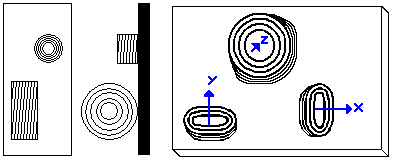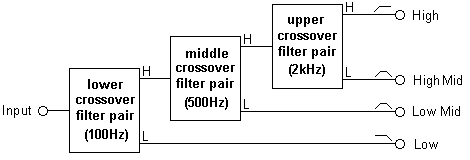DIY Audio Speaker Crossover Wiring Guide / FAQ
People can hear sound frequencies from 20-20,000Hz. There is no one speaker capable of producing all frequencies throughout this range. Therefore, multiple speakers must be used. Usually, it is damaging for a speaker to produce frequencies lower than what it was designed for. Also, if two speakers produce sound at the same frequencies, then the sound at those frequencies will be louder. For these reasons, some type of circuit is necessary to make sure that each speaker only produces a certain set of frequencies. That circuit is a crossover.

No crossover can completely block out all frequencies beyond the crossover point. Instead, it filters the frequencies in greater amounts as the frequency moves away from the crossover point. How fast it filters the sound is determined by the order of the crossover. A 1st order crossover filters 6 db/octave, a 2nd order 12 db/octave, a 3rd order 18 db/octave, and so on. A logarithmic scale is used for the frequencies. An octave is the doubling (or halving) of the frequency. A 2nd order low pass crossover at 1000Hz will decrease the signal by 12db at 2000Hz, 24db at 4000Hz, 36db at 8000Hz...
For reference, a 3db increase is twice as loud and requires twice as much amplifier power to create this increase. For people, however, a 3db change is the minimum noticeable change. It takes a 10db increase for a speaker to "sound" twice as loud. And this 10db increase requires over 8 times more power to create. 2x power for 3db, 4x power for 6db, 8x power for 9db, 16x power for 12db...
What makes a crossover?The basic components of crossovers are inductors and capacitors. Inductors become more reactive (increasing AC resistance) as the frequency increases, and thus lower the sound pressure on the driver more and more as the frequency increase. Capacitors work just the opposite. They have higher AC resistance as the frequency decreases. Inductors, Capacitors, and Resistors are also used in other circuits like Notch Filters and Attenuation Circuits which can sometimes be included in the "crossover".
Why build a crossover?It is a lot cheaper and easier to buy a stock crossover instead of building one, but remember that a generic crossover has not been specifically designed for your speaker drivers. Every speaker is different and the circuit required to achieve optimal performance cannot be found in a catalog. Stock crossovers also tend to use cheaper components like high resistance inductors that use thin wires.
What is phase shift?Phase is the timing of a signal, and the shift is the degree of the delay that occurs on the signal when passed through a crossover. Each order of crossover introduces a 90 degree phase shift. A 180 degree shift is an inverse of the wave. If 2 speakers are 180 degrees out of phase then they will cancel each other wherever they produce the same frequencies. Even with crossovers, both speakers will produce sound for several octaves beyond the crossover point. If this problem occurs, there will be a noticeable dip in the frequency response at the crossover point. To solve this problem, wire one, but not both, of the speakers backwards (+ to -). Usually, phase shift problems only occur with 2nd order (or 6th order) crossovers, but can also occur when using multiple 2-way crossovers in a 3-way (or more) speaker system. The only way to really find and fix a phase shift problem is trying all possibilities in reversing the speaker leads. If reversing the leads makes the system sound louder, then you know you have fixed the problem.
What is inductive coupling?When using more than one inductor in a crossover, the electro-magnetic fields of the inductors can interfere with each other causing an unpleasant result. That is why it is best to keep the inductors as far apart as possible. Also, keep the fields out of phase with each other by rotating the inductors 90 degrees. It is possible to have 3 inductors out of phase, as shown below.

Both inductors and capacitors will have some resistance. Usually, it is small but sometimes it can be greater than the resistance of the speaker itself. Since the entire crossover network is based on the resistance of the speakers, this can be very bad. For an 8 ohm woofer with a low crossover point, the inductor in the low pass filter could be 16 ohms, or even higher. With a combined load of 24 ohms, the amp would not be putting out anywhere near as much power as it should. There are several ways around this problem. The first is to buy expensive components.
What type of inductor should I buy?Inductors are usually just a coil of copper wire, sometimes hundreds of feet long. Copper is the only realistic material to use. One way to lower resistance is to use thicker wire. You can purchase a more expensive coil that uses a heavy gauge wire. Moving from 19g to 14g increases the price by at least 5x's. Using silver increases the cost another 20x's. There are also copper foil inductors which are more expensive, but work somewhat better. Some inductors have iron or ferrite cores in the middle of the coil. This core decreases the amount of copper wire needed for the coil, and therefore lowers the resistance. The problem is that these cores cause some distortion. For smaller inductors, use one without a core - an air core inductor. For the larger inductors required for the woofer's crossover, an air core inductor might not be feasible. In these cases, use a ferrite core. If you want to try to make your own inductor to save money, check out the Inductor Calculator for information on winding your own coils.
What type of capacitor should I buy?For capacitors, a polar Electrolytic capacitor is your basic type. They are cheap, but do not pass high frequencies well. Mylar capacitors are more expensive, but they are better for audio because they work better at the high frequencies, and have less inductance and resistance. Metalized Polypropylene capacitors are the best, but are also much more expensive. Again, be sure to investigate the resistance of these components before purchasing.
What type of resistor should I buy?When selecting a resistor, you have to worry about both Resistance and Wattage. The power handling ability of a resistor is listed in Watts. Make sure your resistors can handle at least the Wattage requirements of your circuit. Metal oxide (MOX) layer resistors have no residual inductance and are the best for tweeters and mid-range speakers. They typically don't have the power handling capability for woofers, where Wire-Wound Sand Cast resistors should be used.
I can't find a inductor / capacitor / resistor of the value I need. What should I do?When you buy inductors capacitors or resistors there are usually only certain values available. These values are referred to the E ranges are discussed in Resistor Colors. That is why the values in the crossover tables for 1st, 2nd, 3rd order Butterworth crossovers have slightly different values than what the Crossover Calculator produces. These tables use commonly available inductors and capacitors. If you cannot find the component you need, then go with the closest match. You can also combine two components in Parallel or Series to get a different value that you can't find normally.
How do I combine 2 (or more) crossovers together in a 3 (or more) speaker system?When working with 3 or more speakers, at least one speaker must be bandpass. Bandpass means that the speaker has a high pass filter (HPF) that filters out low frequencies and lets high frequencies pass through, and a low pass filter (LPF) that filters out high frequencies and lets low frequencies pass through. In a 3-way system, only the mid will be bandpass. In a 4 speaker system, two of the drivers are bandpass. When wiring multiple speakers, you usually start with the largest speaker. All speakers above that one are run through the HPF. A possible 4-way system would look like this.

This diagram has been simplified, and only the positive (+) lead is shown, but you get the idea. The reason for going woofer to tweeter is so that the HPF is before the LPF for each bandpass speaker. The inductors (coils) in a LPF have resistance. This resistance affects the impedance of the entire circuit. If you put the LPF before the HPF, the amp will not have a stable load to work with.
Although the diagrams in this document show each of the high speakers being run through multiple high pass filters, this is not necessary. In the above diagram, the input for the second and third crossover could be directly tied to the main input instead of the high output from another crossover.
What order do I place the components in the crossover?There is no standard as to which parts come first, but the common method is Crossover then L-Pad then Series Notch Filter. Note that the L-Pad and Notch Filters are not required in your crossover.